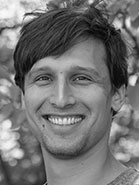|
 Stefan Alaric Schäffer Stefan Alaric Schäffer
A thesis for the degree of Doctor of Philosophy defended August 2019.
The PhD School of Science, Faculty of Science, Precision Measurements with Ultracold Atoms, Niels Bohr Institute, University of Copenhagen
Supervisors:
Prof. Jan W. Thomsen
|
Cavity-enhanced optical clocks
Atomic clocks have revolutionized the world of metrology since their first demonstration in 1955. These frequency measurement devices have led to the possibility of fast communications and computation technologies, navigation systems such as the GPS, and a wealth of fundamental applications that continue to push forward physics. The enormous potential allowed by using atomic clocks continues to motivate their further development and improvement. Atomic clocks have moved from room-temperature samples of atoms to laser-cooled atoms, and are now moving from microwave to optical transitions in the state-of-the-art systems. The further improvement of optical atomic clocks rests on incorporating new techniques, often borrowed from the world of quantum optics. Here we investigate two approaches to optical atomic clocks inspired by spectroscopy and cavity quantum electrodynamics (CQED). These approaches both promise the possibility of continuous clock operation, and seeks to resolve some of the current limitations of atomic clocks.
The first approach relies on cavity-enhanced spectroscopy of cold strontium atoms using the Noise-Immune Cavity-Enhanced Optical Heterodyne Molecular spectroscopy (NICE-OHMS) method. This method is a passive interrogation of the atoms as in current optical atomic clocks, but with a significantly altered measurement method. We investigate the dynamics of the system and quantify the perturbation by the optical cavity. The method uses atomic phase-shift-measurements, and exploits this signal directly as an error-signal in order to stabilize the frequency of the probing laser. The optical cavity is seen to distort the dispersion feature when the atom number increases above a certain threshold, and the consequences for a frequency lock are analyzed.
Theoretical predictions of the obtainable laser linewidth in the mHz range is shown and a preliminary frequency lock is realized. The second approach relies on the same physical system, but is operated in a fundamentally di�erent way. Rather than using the atoms as a passive reference here we seek to have the atoms emit lasing light directly on a narrow atomic transition. This is done within the cavitymodeanalogously to a traditional laser, and constitutes an active approach to the optical atomic clock. The system is operated on the limit of the so-called bad-cavity regime. In this regime superradiant lasing becomes possible, where atomic dipoles synchronize through the cavity mediated coupling, and can emit coherently into the cavity mode. Characterization of the resonant exchange of excitations in the atom-cavity system is performed, and the experiments are shown to exhibit excellent agreement with our theoretical model and simulations. The spectral behavior of the emitted light is analyzed, and an evaluation of the frequency stability is performed. This shows the road for the.
|